With the development of modern industry, packaging has gradually evolved into an indispensable part of people's daily lives. In addition to the function of protecting goods, packaging also affects consumers in many aspects such as vision, touch, smell, etc. In the production of packaging, thermoforming is a commonly used process. Thermoformed plastic packaging has also become an indispensable part of people's daily lives.

Thermoforming is a plastic processing technology. The main principle is by heated plastic sheet makes it soft, and then use vacuum adsorption to adsorb the softened plastic sheet to the surface of the female mold or poistive mold. After cooling, the desired shape is formed.
There are many forming methods used in the actual production process of thermoforming: differential air pressure forming, overmolding, plunger-assisted forming, vacuum forminging, reverse molding and twin sheet forming. Vacuum forming according to the thickness of the sheet is divided into thin gauge thermoforming and thick gauge thermoforming.
Ⅰ. What is Thermoforming Packaging
Vacuum forming packaging is a general term that uses blister technology to produce plastic products and uses corresponding equipment to package the products. Thermoforming packaging products mainly include: thermoforming, vacuum forming tray, thermoforming box.
Thermoforming packaging equipment mainly includes: thermoforming machines, punching machines, sealing machines, high-frequency machines, and folding machines. The packaging products formed by encapsulation can be divided into: slide blister card, carded blisters, double blister card, half-blister shells, clamshell blister card, three-fold blister shells, etc.
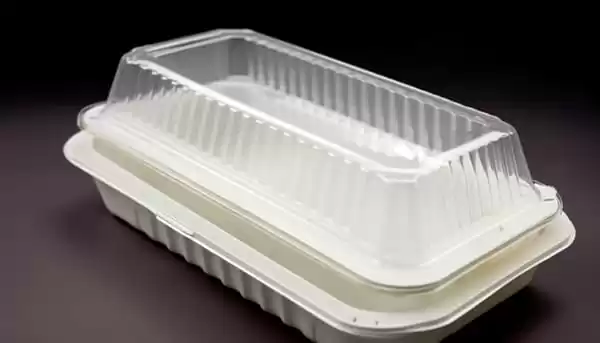
Ⅱ. Common Thermoforming Packaging
Blister Card
The thermoforming process is used to make transparent plastic hard sheets into specific convex shapes, which are covered on the surface of the product to protect and beautify the product. Also known as blister cover, vacuum cover, plastic mask. According to the different forms of the blister card, it can be divided into: blister card, double blister card, slide blister card and carded blister card.

Thermoforming Box
It is a kind of pressure forming product with a cover and a bottom. The one with the bottom and the cover connected together is called a folding thermoforming box, and the one with the bottom and the cover separated is called a bottom cover vacuum forming box.
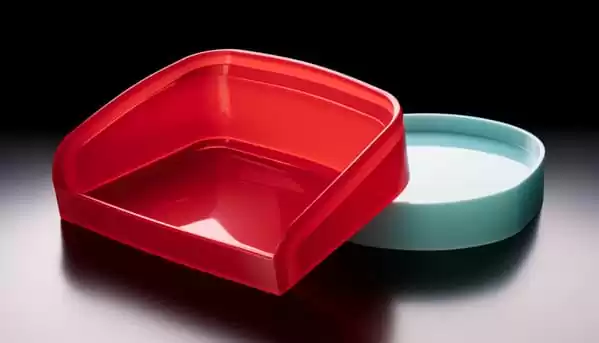
Thermoforming Tray
Also called a plastic inner support, the plastic hard sheet is made into a plastic with a specific groove using vacuum forming process, and the product is placed in the groove to protect and beautify the product.

Flocking Inner Support
It is a pressure forming tray made of special materials. A layer of velvet material is glued on the surface of an ordinary hard plastic sheet, so that the surface of the tray has a velvet feel, which is used to improve the quality of the packaging.
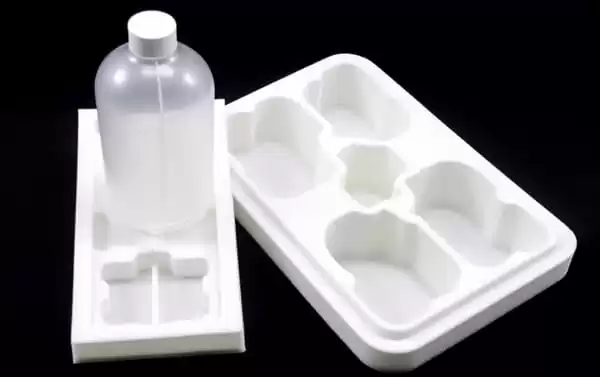
Anti-static Tray
It is a thermoforming tray made of special material. The resistance value on the surface of the material is less than 10 11 ohms. Mainly used for thermoforming trays for electronic and IT products.
Ⅲ. Blister Card Packaging
According to the different forms of thermoforming, it can be divided into: slide blister card, carded blisters, double blister card, half blister packaging, half-fold blister card packaging, etc.
Slide Blister
It refers to the form of packaging in which a paper card and a transparent blister card folded on three sides are inserted together. Its characteristic is that it does not require any equipment when packaging, but it is easy to fall off.

Carded Blisters
It refers to heat sealing the blister card on the surface of the paper card coated with thermoforming oil. Its characteristic is that it requires pressure forming sealing equipment. Requirements for the manufacturing process of carded blisters packaging:
1. The surface of the paper card must be oiled.
2. Can only be PVC and PET.

Double Blister Card
It refers to the form of packaging in which paper cards and products are packaged together in two blister card. Its characteristic is that a high-frequency machine is required to seal the edges of the double blister card, which is inefficient and has high packaging costs. However, the edges are neat and beautiful, and the product has a high-end appearance. The issues that should be paid attention to are:
1. The blister card can only use PVC and PET film, otherwise it cannot be heat-sealed or the heat-sealing effect will be poor.
2. The quality of the high-frequency thermoforming molds determines the quality of the double blister card edge.
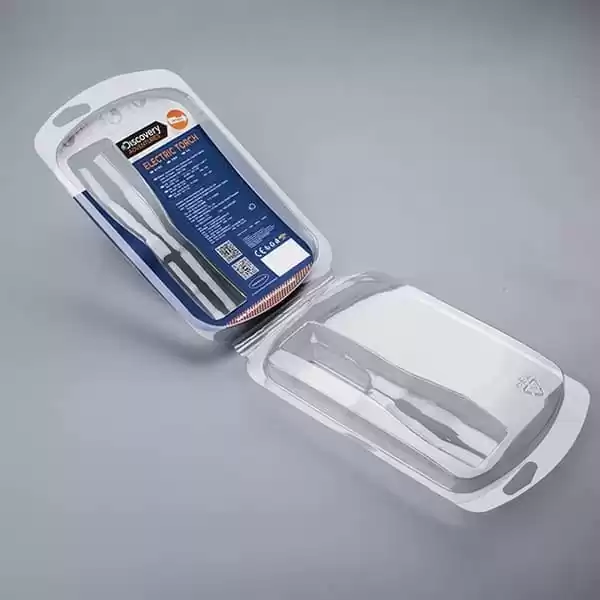
Half Blister Card
It refers to the packaging form in which the paper card and the product are packaged together with two blister cards, but the product is partially exposed outside the blister card. It is suitable for particularly long products. Its characteristic is that it requires manual scissors to cut the exposed part of the blister card, and then use a high-frequency machine to seal the edges of the double blister card. The efficiency is low and the packaging cost is high, but the visual effect is good and it can satisfy users in supermarkets. When selecting products, directly touch the demand for the product. Issues that should be noted:
1. Products that are easily stained are not easy to use this type of packaging.
2. When cutting holes in the blister card, pay attention to neat edges.
3. The blister card must be made of PVC or PETG hard sheet.
Clamshell Blister Card
It means that one side of the double blister card is connected together during pressure forming, and then folded in half to form the bottom and surface of the double blister card. Its characteristic is that instead of using high-frequency sealing edge technology, buckles are made at certain positions of the blister to connect the double blisters. If necessary, staples can be added. In terms of material selection, PET hard sheets can be used to achieve environmental protection. The purpose of the material. Issues that should be paid attention to during the plastic manufacturing process:
1. Since there is no high-frequency machine for edge sealing, the edges need to be cut with high quality on the cutting machine.
2. The tightness of the buckle should be moderate.
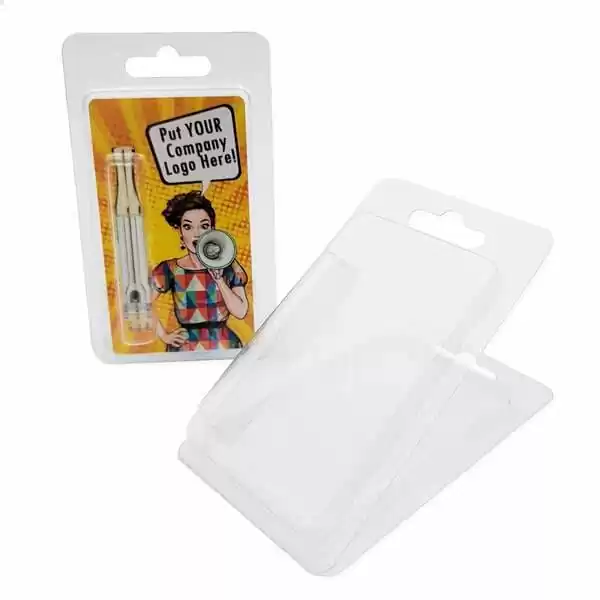
Ⅳ. Advantages of Thermoforming Packaging
1. Thermoforming packaging can meet the diversified protection requirements of goods and significantly improve the shelf life of goods. Printing technology. There are various soft packaging functional materials, which can not only meet the barrier properties of water vapor, gas, grease, organic solvents and other substances, but also meet the requirements of anti-rust, anti-corrosion, anti-electromagnetic radiation, anti-static, anti-chemical and other requirements. As well as requirements such as sterility, preservation, non-toxicity and pollution-free.
2. Thermoforming packaging products have a simple process and are easy to operate and use. As long as product manufacturers and packagers purchase high-quality, specific functional flexible packaging materials and equipment, they can produce their own packaging, and the technical requirements are easy to master for central printing. Flexible packaging products are easy to open and use.

3. Thermoforming packaging has relatively strong product appeal and is particularly suitable for sales packaging that requires printing technology. Flexible packaging is the most friendly packaging form printing tool. Flexible packaging material products are light, soft and comfortable to the touch, and are suitable for colorful printing. They have good information transmission effect and give consumers a sense of good reputation.
4. Save packaging costs and transportation costs with printing technology. Since most flexible packaging materials are soft and lightweight films and sheets, the packaging is close to the body, the packaging material occupies a small weight, and there is little void space in the packaging. The circulation and transportation of goods are very convenient, and the transportation cost is much lower than that of goods with rigid packaging.
5. Thermoforming packaging has relatively low resource and energy consumption and also has great advantages in environmental protection. Flexible packaging uses less natural materials, the weight ratio of packaging materials to contents is very small, and the ratio of packaging volume to contents volume is also small.
6. At the same time, in terms of the variety and quantity of resource consumption, thermoformed flexible packaging has incomparable advantages over other packaging forms. The material of thermoformed packaging is relatively light and soft, and is easy to fold and pack. The recycling, processing and transportation of waste materials of thermoformed flexible packaging can be said to be quite convenient. There are many methods of waste treatment, depending on the nature of the waste materials. Methods such as landfill, incineration, decomposition, and regeneration are adopted respectively.
Ⅴ. Commonly Used Materials for Thermoforming Packaging
The main raw materials of thermoforming packaging boxes mainly include the following:
1. PVC: PVC sheet is a widely used and popular material. The hard sheet has high toughness and is not easy to burn. It will produce chlorine gas when burning, which will cause certain obstacles to the environment. PVC is easy to heat seal, and can be sealed with a sealing machine and high-pressure sealing machine. Frequent machine edge sealing is an important raw material for the production of transparent blister products.
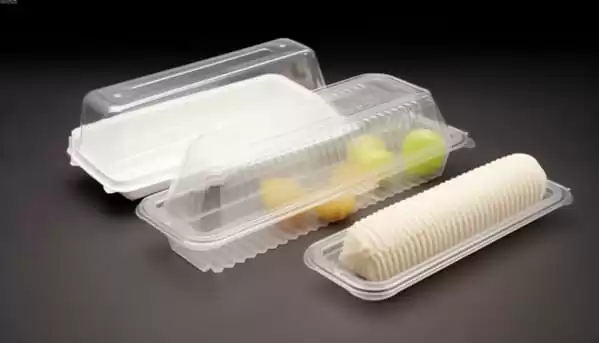
PVC film can be divided into two types: environmentally friendly and non-environmentally friendly. It can be made into various blister packaging products such as translucent, colorful, anti-static, gold-plated, and flocked. Its characteristics are high transparency, good surface gloss, few crystal points, and water content. It has small grain, wide application, strong impact resistance, and is easy to shape.
The products comply with the US FDA and Japanese PL food hygiene standards. The products are widely used in toys, food, electronic products, medicine, electrical appliances, gifts, cosmetics, stationery and other products. Outer packaging.
2. PS: PS hard sheets have low density, poor toughness, and are easy to burn. When burned, they produce styrene gas (a harmful gas), so they are also used to produce various industrial blister trays. Therefore, it is also used to produce various industrial blister trays.
3. PP: PP has good heat resistance and chemical stability, and is suitable for food packaging that requires high-temperature sterilization. It has the characteristics of light weight, bright and quiet surface, good heat resistance, high mechanical strength, excellent chemical stability and electrical insulation, and non-toxicity.
4. PET (polyethylene terephthalate): PET sheet is a new material that has developed in recent years. With its excellent toughness, high strength, high transparency, and recyclability, PET sheet does not produce harmful substances when burned. Due to the excellent environmental performance of the gas, PVC is gradually banned as an environmentally friendly material, and is greatly favored by consumers and producers, but the price is high.
Suitable for making high-end blister products, blister blister shells in European and American countries also require the use of PET material, but its thermal melting point is high, which brings great difficulties to high-frequency packaging. In order to solve this problem, people composite the surface of PET. A layer of PVC film is named PETG, but the price is higher. Mainly used in electronics, food, toys, color box windows, collar supports, footwear packaging, etc.

5. PETG: Also called GPET sheet, it is made of a non-crystalline PET resin modified with cyclohexanediol. The biggest advantages of PETG sheets are good heat sealing performance, easy operation during sealing, good sealing effect and easy glue bonding.
At the same time, its chemical resistance, optical properties, and scratch resistance are also very good. PETG has passed the US FDA's food contact standards and can be used in food and personal health product packaging, medical and health equipment and food, and can also be used in electronic device packaging.
6. GAG three-layer composite sheet: GAG is a three-layer composite sheet produced by co-extrusion of the middle layer APET and the upper and lower layers of PETG raw materials in an appropriate proportion. It is specially suitable for packaging that requires high-frequency heat sealing and glue bonding. box.
Ⅵ. Application of Thermoforming Packaging
1. For packaging hardware spare parts, electronic components, modules, module PC boards, etc., this thermoforming packaging can be made of four different materials according to different requirements. These products generally need to be stored in categories, so they need a packaging box that is strong, beautiful and easy to identify. Thermoforming packaging boxes can be produced using PVC, PS, PP, flocking, conductive and other materials according to different requirements.
2. For digital products, electronics, and toys, this is usually a transparent thermoforming packaging made of PVC or PET. Thermoforming packaging boxes have very high transparency and can clearly display products, so they are widely used in digital products, toys and other industries.

3. Thermoforming packaging made of PET and PVC has high transparency and good surface gloss. The products are widely used in the outer packaging of toys, food, electronic products, medicine, electrical appliances, gifts, cosmetics, stationery and other products.
4. For food packaging, it is used to hold vegetables, fresh fruits, dumplings, glutinous rice balls and other frozen foods. As a food packaging product, it can also be used to package chocolate, candy, biscuits, fruits and vegetables, fresh food and other foods. This kind of packaging box is generally made of PET or PVC material, which has the characteristics of high transparency and good surface gloss.
5. Gifts, stationery and other industries: Thermoforming packaging boxes can be used to package gifts, stationery, electrical appliances and other products. They not only have a beautiful appearance, but also provide sufficient protection for the products. At the same time, vacuum forming packaging boxes can also be personalized to increase the added value of the product.
Ⅶ. Advantages of Thermoforming Technology in Packaging Production
1. High aesthetics
Thermoforming process uses high temperatures to heat plastic sheets to their melting point, and then uses suction to mold them into various shapes. The packaging boxes produced by this process are highly aesthetic and three-dimensional, which can improve the grade and brand image of the product to a certain extent, thus attracting more consumers.
2.Durable and firm
Thermoforming materials are usually made of polyethylene (PE), polyvinyl chloride (PVC) and other plastic materials, which have excellent corrosion resistance such as water resistance, acid resistance, and alkali resistance. The use of pressure forming technology in packaging production can strengthen and solidify the plastic material, making it stronger and more durable, thus providing better protection for the goods.
3. Various specifications
Through the thermoforming process, packaging boxes of various shapes, sizes, and colors can be produced to meet the diverse needs of consumers. Whether it is items with complex shapes or small and exquisite items, they can get suitable packaging shells with the help of thermoforming technology, thus providing greater convenience for the promotion and sales of goods.

4. Good environmental performance
Since modern society pays attention to environmental protection, environmental factors also need to be considered during the production process of vacuum forming. Usually, thermoforming materials are recyclable plastic materials, which means that the processed waste materials can be recycled and reused, thereby achieving environmental protection purposes. In addition, the pressure forming process does not require the use of any harmful chemicals, nor does it cause pollution to the environment, and has good environmental performance.
Conclusion
The thermoforming packaging industry will become the focus of future development. In today's daily life, every industry and every field requires various plastic packaging. Therefore, thermoforming packaging will determine the high-end and low-end positioning of products. From the current market demand It seems that with the continuous improvement of consumption levels around the world, the sales trend of retail markets around the world is showing an obvious upward trend, so packaging can be said to be a big market in the next few years.
The packaging boxes produced through the thermoforming process have excellent performance in terms of aesthetics, durability, variety of specifications, and environmental protection. Therefore, vacuum forming is widely used in the packaging production of various commodities, and creates a beautiful, practical, and environmentally friendly packaging appearance for the commodities, improves the grade and brand image of the commodities, and creates greater business opportunities for commodity sales.




